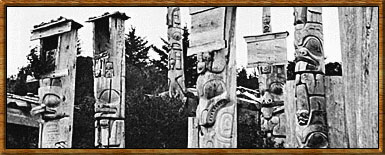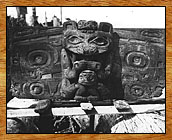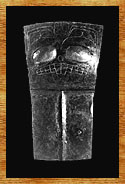 
|
Skungwai (Ninstints)

Ninstints, the name under which this village was declared a World Heritage Site by UNESCO in 1981, is also the name of the town chief in the middle of the last century. An earlier town chief in the late eighteenth century whose name was Koyah had his attack on a trading ship immortalized in a folk song popular among New England whalers:
Come all ye bold Northwestmen who plough the raging main,
Come listen to my story, while I relate the same;
'Twas of the Lady Washington decoyed as she lay,
At Queen Charlotte's Island, in North America.
On the sixteenth day of June, boys, in the year Ninety-One,
The natives in great numbers on board our ship did come,
Then for to buy our fur of them our captain did begin,
But mark what they attempted before long time had been.
The Haida name of Skungwai (or Red Snapper Island Town) refers to the small island behind which the village shelters. The island on which the village sits is called Kunghit (or Anthony) Island. Skungwai has taken on a symbolic status today, primarily because its remote location helped to preserve more in situ totem poles there than in any other Haida village. Two tragedies, however, claimed some of the beautiful poles from Skungwai. The first was a fire in the last century, which burned one end of the village and half a dozen poles; it was supposedly set by the Heiltsuk people in retaliation for a raid. The second was another fire, which destroyed the workshop of the Queen Charlotte Islands Museum at Skidegate, where seven poles from Skungwai had been sent for restoration. These lost poles were part of a collection of more than a dozen of the finest poles from Skungwai that had been taken to the Royal British Columbia Museum in Victoria by a salvage expedition in 1957 under the leadership of Professor Harry Hawthorn, Professor Wilson Duff, Michael Kew and Bill Reid. The museum lent some of the poles to the University of British Columbia Museum of Anthropology, where they are still located, and returned the remaining seven to Skidegate, only to meet the tragic end already described.

 |
A portrait of Chief Ninstints (Tom Price, left) and Chief Giatlins (John Robson, right). Tom Price (circa 1860-1927) was the last traditional chief of Ninstints (Skungwai) to live in the village and was also a talented carver of argillite. John Robson, a famous carver, was the successor to Chief Giatlins and stepfather of Charles Edenshaw.
Studio portrait by an unknown Victoria photographer circa 1884. |

About a dozen poles still stand at Skungwai, all mortuary posts, now missing their frontal boards. The bones and objects they once held, such as coppers and labrets, were scattered or stolen by enthusiastic collectors over the course of more than a century.

 |
The front of a chief's burial chest from Skungwai (Ninstints), made in the style of the early nineteenth century. The central figure of a Bear is in high relief and once had abalone shell inlay in the eyes, ears, hands and knees. The bas-relief carvings on the flanking panels were also once inlaid with abalone shell.
Collected at Skungwai (Ninstints) in 1897 by Charles F. Newcombe. |

 |
From Skungwai (Ninstints) village, a small copper shield depicting a Beaver. The protruding eyes on this figure appear to have been reworked from the original heavily oxidized metal but were not engraved with the expected salmon-head eye designs.
Collected at Ninstints in 1897 by Charles F. Newcombe.
CMC VII-B-377 (S94-6769) |

|